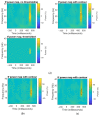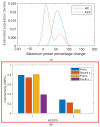Functional Connectivity and Frequency Power Alterations during P300 Task as a Result of Amyotrophic Lateral Sclerosis
- PMID: 34696014
- PMCID: PMC8541445
- DOI: 10.3390/s21206801
Functional Connectivity and Frequency Power Alterations during P300 Task as a Result of Amyotrophic Lateral Sclerosis
Abstract
Amyotrophic Lateral Sclerosis (ALS) is one of the most aggressive neurodegenerative diseases and is now recognized as a multisystem network disorder with impaired connectivity. Further research for the understanding of the nature of its cognitive affections is necessary to monitor and detect the disease, so this work provides insight into the neural alterations occurring in ALS patients during a cognitive task (P300 oddball paradigm) by measuring connectivity and the power and latency of the frequency-specific EEG activity of 12 ALS patients and 16 healthy subjects recorded during the use of a P300-based BCI to command a robotic arm. For ALS patients, in comparison to Controls, the results (p < 0.05) were: an increment in latency of the peak ERP in the Delta range (OZ) and Alpha range (PO7), and a decreased power in the Beta band among most electrodes; connectivity alterations among all bands, especially in the Alpha band between PO7 and the channels above the motor cortex. The evolution observed over months of an advanced-state patient backs up these findings. These results were used to compute connectivity- and power-based features to discriminate between ALS and Control groups using Support Vector Machine (SVM). Cross-validation achieved a 100% in specificity and 75% in sensitivity, with an overall 89% success.
Keywords: ALS; BCI; EEG; classifier; connectivity; frequency-specific; neural.
Conflict of interest statement
The authors declare no conflict of interest.
Figures













References
-
- Kellmeyer P., Grosse-Wentrup M., Schulze-Bonhage A., Ziemann U., Ball T. Electrophysiological correlates of neurodegeneration in motor and non-motor brain regions in amyotrophic lateral sclerosis—Implications for brain-computer interfacing. J. Neural Eng. 2018;15:041003. doi: 10.1088/1741-2552/aabfa5. - DOI - PubMed
-
- Iyer P.M., Egan C., Pinto-Grau M., Burke T., Elamin M., Nasseroleslami B., Pender N., Lalor E.C., Hardiman O. Functional connectivity changes in resting-state EEG as potential biomarker for Amyotrophic Lateral Sclerosis. PLoS ONE. 2015;10:e0128682. doi: 10.1371/journal.pone.0128682. - DOI - PMC - PubMed
-
- Fraschini M., Demuru M., Hillebrand A., Cuccu L., Porcu S., Di Stefano F., Puligheddu M., Floris G., Borghero G., Marrosu F. EEG functional network topology is associated with disability in patients with amyotrophic lateral sclerosis. Nat. Publ. Gr. 2016;6:1–7. doi: 10.1038/srep38653. - DOI - PMC - PubMed
MeSH terms
LinkOut - more resources
Full Text Sources
Medical
Miscellaneous

